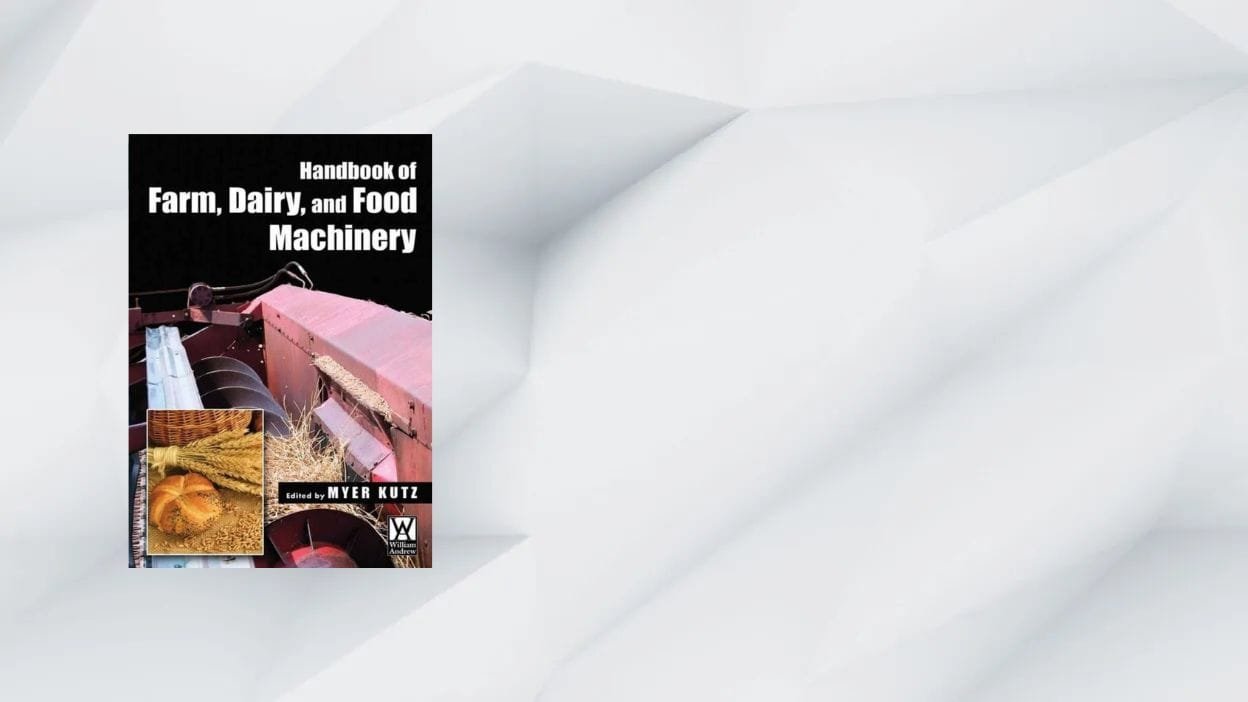Book at a Glance
| Detail | Value |
|---|---|
| Editor | Myer Kutz |
| Edition / Year | 3rd Edition (18 June 2019) |
| Pages | ≈ 735 pp. |
| Publisher | Academic Press (Elsevier) |
| ISBN | 978‑0‑12‑814803‑7 (Print) |
| Target Readers | Agricultural, dairy & food engineers; senior undergrads; post‑grads |
| Primary Keyword | Handbook Of Farm, Dairy, And Food Machinery |
Why the Handbook Of Farm, Dairy, And Food Machinery Matters
From autonomous tillage vehicles to ohmic heating of meat, modern agro‑food operations rely on multidisciplinary machinery. This handbook pulls farm equipment, dairy processing, and food‑plant technology into one farm‑to‑fork reference, giving both students and practicing engineers quick access to theory and design formulas. New chapters on UAV applications and engineering properties of foods reflect the industry’s shift toward precision agriculture and data‑driven process control.
Chapter Highlights
- The Food Engineer — career paths, required skills, and future opportunities.
- Food Regulations & Safety Engineering — HACCP, FSMA, and traceability systems every plant designer must heed.
- Farm Machinery Automation — GPS/RTK guidance, implement control, and the challenges of autonomous harvesters.
- Microwave & Ohmic Heating — design parameters for rapid, uniform thermal processing of grains, cocoa, meats, and ready‑to‑eat meals.
- Packaging & Seaming — double‑seam integrity, closures for glass, and sustainability trends in biopolymer films.
- Facility & Logistics Design — floor‑plan templates, cold‑chain considerations, and energy‑efficiency checklists.
(Each chapter ends with rich reference lists—gold for thesis writers.)
Strengths
- Breadth + Depth – 50 + focused chapters give you both overview narratives and calculation worked‑examples.
- Up‑to‑Date – covers UAV crop surveys, microwave vacuum drying, and IoT‑based monitoring added in the 2019 update.
- Illustration‑Heavy – 1,000+ figures, cut‑away diagrams, and flow‑charts eliminate guesswork.
- Cross‑Disciplinary – integrates mechanical design, material science, microbiology, and regulatory topics, mirroring real plant‑floor challenges.
Limitations
- Pricey – technical handbooks from Elsevier rarely come cheap; budget‑minded students may need library access.
- Dense Language – novice readers may find some sections (e.g., rheology equations) intimidating.
- Limited Software Tutorials – CAD/CFD workflow examples are brief; you’ll still need separate software references.
How It Compares
| Book | Scope | Best For |
|---|---|---|
| Handbook Of Farm, Dairy, And Food Machinery | Machinery design and process operations “farm‑to‑fork” | Broad reference, design projects |
| Food Engineering Handbook | Primarily process engineering thermodynamics | Researchers needing modeling depth |
| Modern Dairy Technology | Dairy processing only | Plant managers & QC specialists |
SEO‑Friendly FAQ
Q1. Is the Handbook Of Farm, Dairy, And Food Machinery suitable for final‑year engineering projects?
Yes—its formula tables and case studies help define design specs and justify material choices.
Q2. Does the 3rd edition include precision‑agriculture topics?
Absolutely. A dedicated chapter covers UAV imaging, variable‑rate seeding, and sensor fusion.
Q3. How does it address food safety?
Three early chapters walk through FSMA, sanitation equipment design, and real‑time pathogen monitoring.
Q4. Where can I buy or access it?
Elsevier’s ScienceDirect, major academic libraries, and online retailers such as Amazon.

